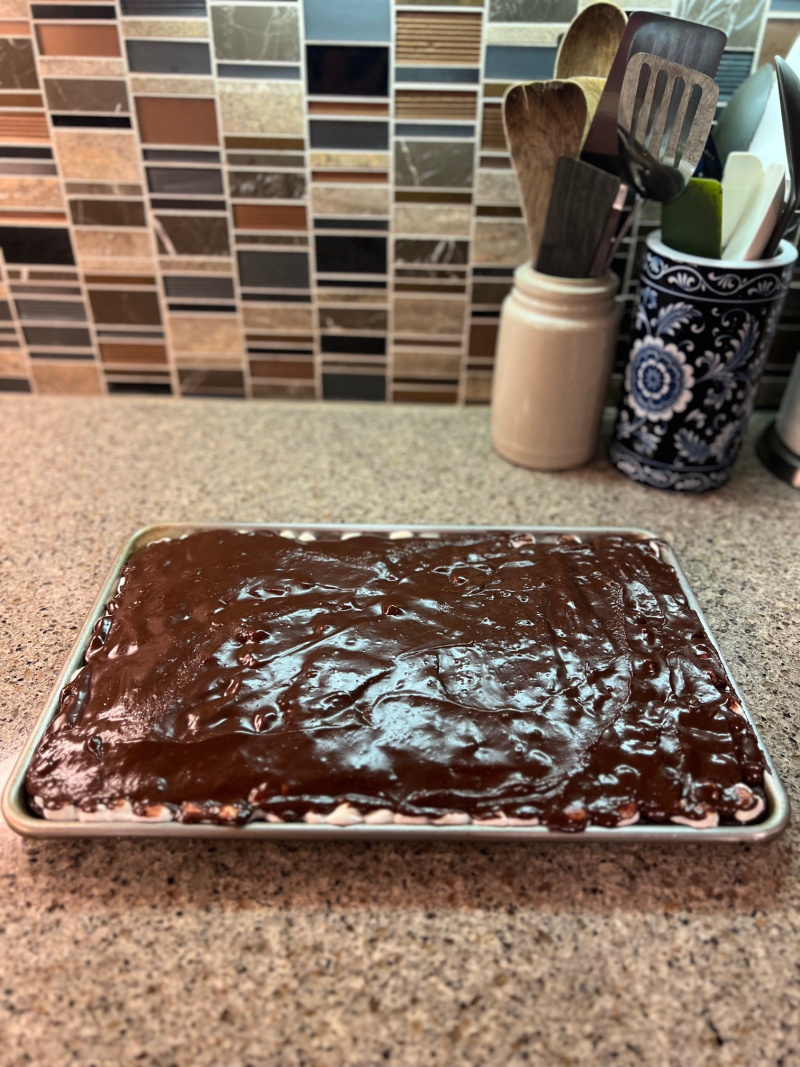In preparation for a playdate, my daughter and I once again flipped through the sections devoted to sweets and decided to make LaVina Grindberg’s recipe for “Chocolate Marshmallow Squares” (Cakes, Cookies & Candy).
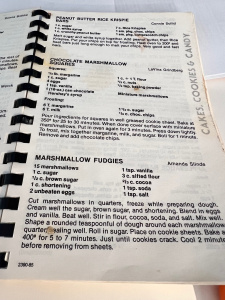
Once again, the reader was assumed to have basic knowledge of baking, as the first instruction was to “pour ingredients for squares in well greased [sic] cookie sheet.” I took the liberty of assuming that I needed to mix the ingredients prior to pouring them, and I used my knowledge of baking to do this in an orderly fashion—“wet” ingredients mixed separately from “dry,” then the bulky, like nuts. I also again took the liberty of substituting butter for the prescribed margarine.
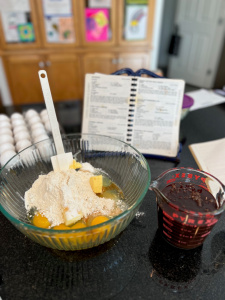
It is good that I continued reading the instructions prior to beginning to mix, since the miniature marshmallows might cause a bit of consternation. They are not supposed to be mixed with the batter for the “squares” but are included in that list (underneath the first ingredient list is an additional list for the frosting). Both “squares” and “frosting” are indicated typographically as disparate; each is followed by a colon and line space to introduce the listed ingredients. The only hint in the ingredient list that marshmallows should not be mixed in the batter is a slight visual separation, an additional line space after the ingredients for the batter. However, a conscientious cook would read the entire recipe ahead of time, we assume, and thus would encounter the third sentence in the paragraph of instructions, explaining that the miniature marshmallows should be added after the squares have baked for 25 to 30 minutes.
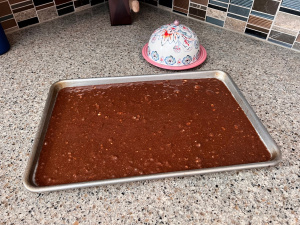
I wasn’t sure how many marshmallows to use, as no amount was listed. So I covered the squares, which had a fudgy cake-or-brownie-like consistency, with marshmallows completely, one layer deep, prior to the additional three minutes of baking to melt them slightly into the base layer.
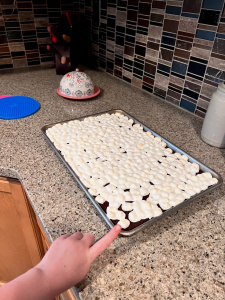
I also wasn’t certain about what type of nuts to use; I’ve seen this generic labeling elsewhere in the cookbook too, most often regarding cheese. Cheese, nuts? All varieties must taste the same and behave the same way. 😊 All kidding aside, this use of a generic category of nuts or cheese suggests limited variety of types of nuts and cheese available for purchase or maybe strong prescription for what types of nuts and cheese should be used. I might be expected to just know what variety of nuts are appropriate. I like walnuts, pecans, and peanuts in sweets, and so I decided to use walnuts, given their ubiquity in other chocolate-based recipes, like brownies, blondies, and chocolate-chip cookies.
It also was interesting to use chocolate syrup (with the name-brand Hershey’s specified), and I was surprised to find that I could not find the 16 ounce cans in the grocery store (maybe cans have been retired because of BPA concerns?) and had to buy a 24 ounce squeeze bottle and measure it into a two-cup Pyrex container. I didn’t expect this ingredient, but I’ve already made another recipe for brownies with Hershey’s syrup and discovered many others that use it in the cookbook. I’ve run into the boxed cake and brownie mixes that have packets of chocolate syrup as an ingredient, but I wasn’t aware of this as a popular substitute for cocoa powder. I will be looking into this further; if anyone knows anything about this history, please let me know!
The frosting was fun to make, and it smelled like the frosting my mother would make when I was a child. The consistency seemed too runny to me with the specified amount of ingredients; I added another quarter cup of chocolate chips to thicken it. Then I did that again and thought it looked gorgeous.
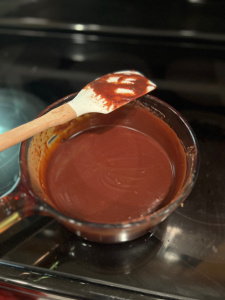
These were very rich! Luke pronounced them “decadent” (in an ironic voice he uses to imitate mothers from when we were growing up), and I could only eat a very small square, given my decreasing tolerance for sweet flavors as I age. But these were extremely popular with children—first my daughter and her friend during her playdate the next day, then later with some friends who are in middle school, then with our friends/neighbors who came over for a taco and pool party. The younger kids advised leaving out the nuts in the future.
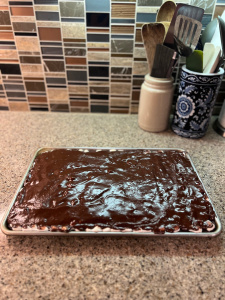
I did not recognize LaVina Grindberg’s name, but my mother explained that I knew two of her four children—Cindy Culbertson, who taught reading at the Velva school, and Cheryl Vinesett, but not the others—Vicky Hart and Barry Grindberg. LaVina Krumwiede was born in 1916, and grew up one mile north of Voltaire on the farm her father, William, homesteaded. William and his wife Fredarica (Bohner), also of Voltaire, had seven children, and LaVina was the fifth child. She married Victor Grindberg in 1942 and lived on a farm six miles east of Velva. As of the publication of the McHenry County historical book in 1985, LaVina and Victor had lived on their farm for thirty-five years, and she had taught for thirty-three years, including twenty in Velva. Their farm had an unusual history, as it had been the McHenry County Home Farm, or the county’s “poor farm” from 1923 until a fire destroyed the residential building on July 4, 1946. You can read a history of the McHenry County Poor Farm in Chapter 17 of Prairie Paupers: North Dakota Poor Farms, 1879-1973, Steven R. Hoffbeck’s 1992 doctoral dissertation for his Ph.D. in history at UND, Grand Forks: http://theusgenweb.org/nd/dunn/history1879-1973PrairiePaupersPoorFarms.pdf. LaVina’s other contributions to the cookbook are “Salted Nut Roll” and “Vegetable Salad” (which I considered making as my vegetable side recently, as the ingredients list consists of five types of vegetables. But the instructions add two secret binders: mayo and Cool Whip! I was not prepared for that twist. However, the instructions end with the evaluation “so good!” so maybe I need to try this out).
I love talking about names—connotations, denotations, patronymics, contemporary naming practices, the symbolism of character names, and so on. Ask my students! There’s so much to unpack. As I sift through the cookbook and the McHenry County book, I feel like I’m pulling a thread in something knitted. I can’t stop moving back and forth across the pages to the index to fit these family relationships together, delighted by recognizing ties new to me. I did not realize that some Krumwiedes, Grindbergs, Culbertsons, and Vinesetts were related. Certainly, the practice of women taking a male spouse’s name has obscured the visibility of family relationships for those of us who are not in that family. I wonder what keeping my last name as “Knutson,” the last name with which I was born, will look like someday. Will it be easier for any possible great- or great-great grandchildren to situate me in a “family tree”? Or will “Knutson” be unrecognizable to them? Will they be interested in where I was from or who I was? Their community will look different, as does my daughter’s already, undoubtedly without several generations living close together in the same area. They may still be interested in sorting out who is who (Ancestry.com is extremely popular), but their research methods will be different. I have a difficult time imagining circumstances that would bring about another collective community writing project like McHenry County: Its History and Its People.
This post is part of an ongoing series in which I make and reflect on recipes and the people who contributed them to the 1985 Oak Valley Lutheran Church compiled cookbook, The Joy of Sharing.

